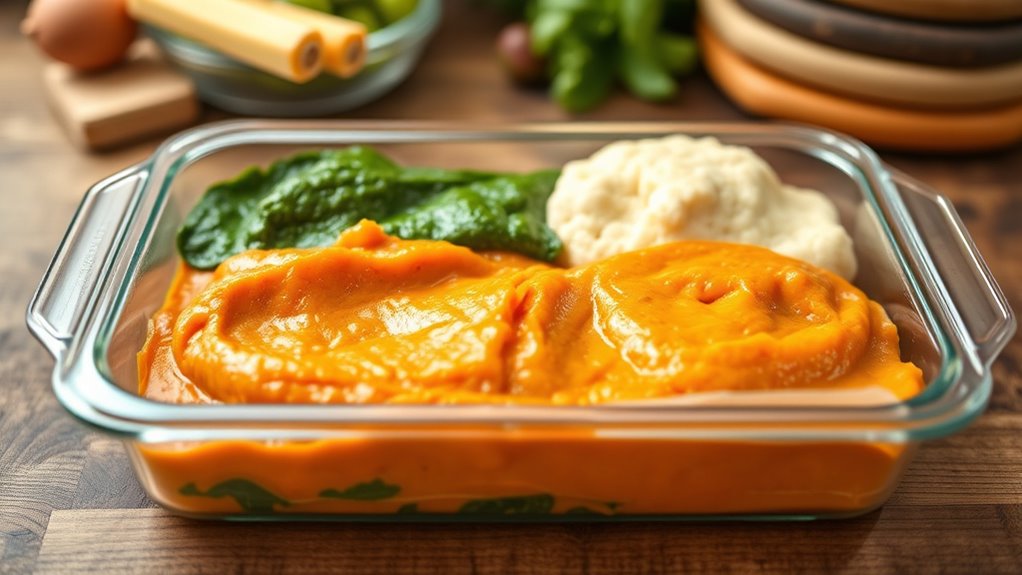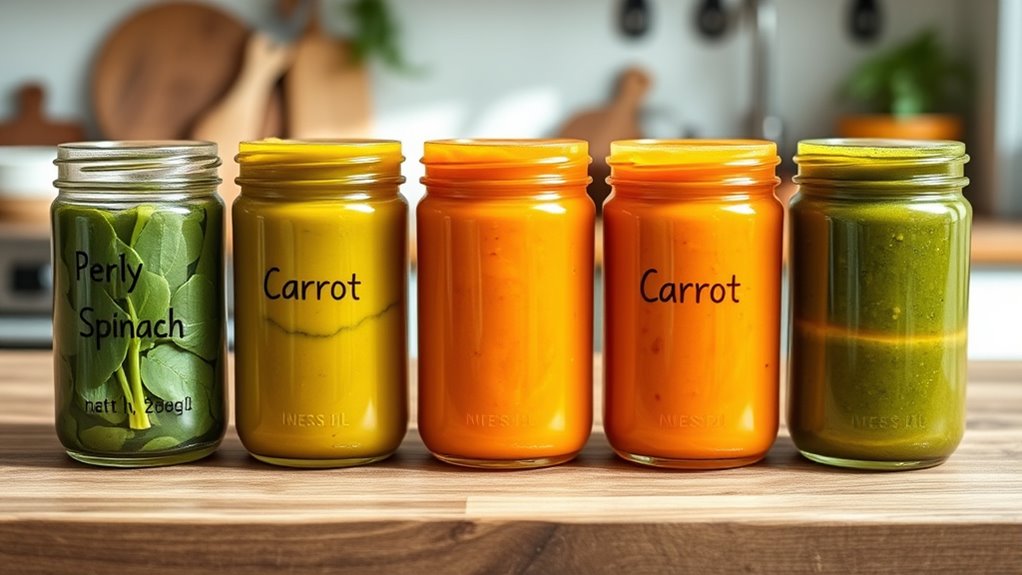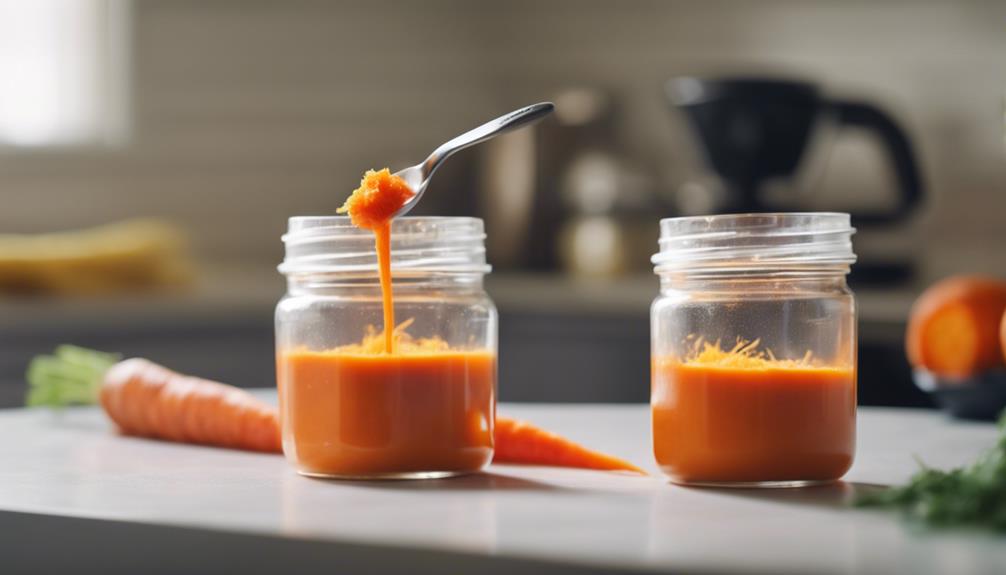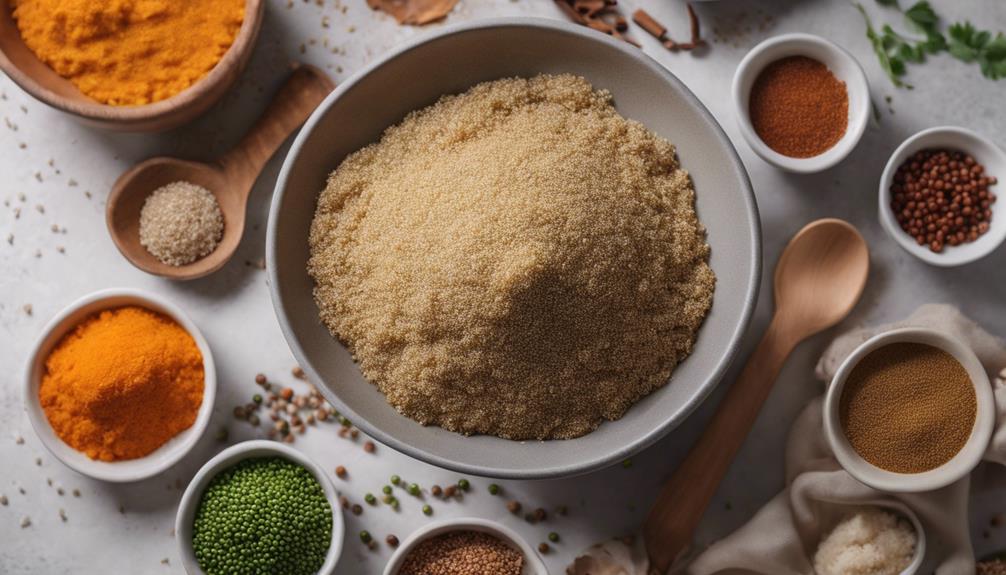Batching make-ahead purees is a great way to save time on busy weeknights. Use small, airtight containers or silicone ice trays to portion and freeze your favorite fruits and veggies. Label and store them in the freezer for quick access later. Thaw in the fridge overnight or use warm water or microwave for faster options. Keep exploring for more tips to keep your puree stash fresh and ready to go.
Key Takeaways
- Use small, airtight containers or silicone ice cube trays to portion purees for quick, easy thawing.
- Label frozen purees with dates to ensure freshness and proper rotation.
- Cool purees completely before freezing to prevent condensation and extend shelf life.
- Thaw purees in the fridge overnight or quickly in warm water or microwave for busy weeknights.
- Store purees in the freezer at or below 0°F, and utilize vacuum-sealed bags for longer preservation.

Making purees ahead of time is a smart way to save meal prep stress and guarantee you always have healthy, flavorful options on hand. When you prepare purees in advance, you’re adopting effective meal prep strategies that streamline busy weeknights. Instead of scrambling to cook and mash vegetables or fruits last minute, you can portion out your purees in advance, making dinner prep quick and efficient. This approach not only saves time but also ensures you’re serving nutritious, homemade food with minimal effort. To maximize this benefit, it’s essential to focus on proper storage tips that keep your purees fresh and preserve their flavors and nutrients.
First, consider using small, airtight containers or silicone ice cube trays to portion your purees. This allows you to freeze individual servings, which thaw quickly and evenly when needed. Label each container with the date to keep track of freshness. When freezing, leave some space at the top of containers because liquids expand as they freeze. Once fully frozen, you can transfer the cubes into freezer bags for more compact storage. This method helps you avoid freezer burn and makes it easy to grab just what you need without defrosting an entire batch.
Another storage tip is to use vacuum-sealed bags if you have the equipment, as they remove excess air and extend the shelf life of your purees. When storing in the freezer, aim to keep the temperature at or below 0°F (-18°C) to maintain quality. Before sealing, let the purees cool completely to prevent condensation inside containers, which can lead to spoilage. When it’s time to use the purees, transfer them to the fridge the night before to thaw slowly. For quicker options, use the microwave or run the frozen cubes under warm water to loosen them. Regular maintenance, such as monitoring air quality, can help ensure your freezer environment stays optimal to prevent spoilage.
In addition to freezing, you can store purees in the fridge for up to three days if you plan to use them within that timeframe. Keep the purees in a sealed container, and avoid leaving them out at room temperature for extended periods. If you notice any off smells or discoloration, discard the puree to prevent foodborne illnesses.
Frequently Asked Questions
How Long Can Purees Be Stored in the Freezer?
You can store purees in the freezer for up to 3 to 6 months, depending on how well you package them. To guarantee freezer safety and maintain quality, use airtight containers or freezer bags, removing excess air. Label each with the date, so you know when to use them. Proper storage duration helps prevent freezer burn and preserves flavor, making your purees ready for quick meals later.
What Is the Best Way to Reheat Frozen Purees?
To reheat frozen purees, you can use microwave reheating or thawing techniques. For quick results, microwave the puree on low power in short bursts, stirring in between to distribute heat evenly. If you prefer, thaw the puree in the fridge overnight before gently reheating on the stove or in the microwave. Always check the temperature, ensuring it’s heated thoroughly for safe and delicious meals.
Can I Mix Different Purees Together Before Freezing?
Ever wonder if you can mix different purees before freezing? The answer is yes, but with some caution. Puree combinations can create delightful flavors, but you need to take into account freezing compatibility. Some purees may not freeze well together, leading to texture issues. Test small batches first, and make sure the flavors complement each other. This way, you’ll enjoy perfectly mixed purees that stay fresh and delicious when thawed.
Are There Any Purees I Should Avoid Freezing?
You should avoid freezing dairy-based purees, like yogurt or cream cheese, because they tend to separate and change texture when thawed. Fruit purees generally freeze well, but some, like banana or avocado, may turn brown or become grainy. If you’re unsure, test a small amount first. Always use airtight containers to prevent freezer burn, and label your purees with dates for best freshness.
How Do I Prevent Freezer Burn on Purees?
A stitch in time saves nine, so you want to prevent freezer burn on purees. To do this, always use airtight containers and guarantee proper sealing. Squeeze out excess air before sealing, and leave some headspace for expansion. Properly stored, your purees will stay fresh longer, maintaining flavor and texture. Remember, prevention is better than cure, so take these steps to keep your purees delicious and freezer-burn free.
Conclusion
Now that you’ve got these five make-ahead purees in your freezer arsenal, your weeknights will run smoother than a well-oiled machine. Imagine opening your freezer and instantly transforming a hectic dinner into a five-star meal—all thanks to these flavor-packed, perfectly portioned purees. With just a quick thaw, you’ll have a gourmet touch ready in seconds. Say goodbye to dinner stress and hello to culinary confidence—your freezer is now your secret weapon for busy nights!










